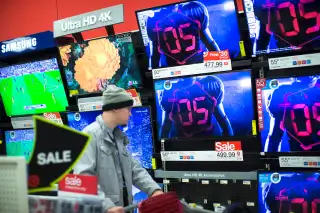Should You Buy a TV Before the Super Bowl?

So, you're hosting a Super Bowl party this year. You make a killer buffalo chicken ranch dip that would make Guy Fieri weak in the knees, and you'll have more beer on hand than a frat house at a Big Ten school on game day.
But there's one, minor detail about having a bunch of people over to watch a football game that you've, to this point, neglected to take care of -- your TV.
Should you buy a new one before the big game? How much should you spend on it?
According to a survey by consumer deals site FatWallet, price is the first thing people consider when purchasing a TV, before features and brand preference. And most people are willing to spend more than $500 on a TV. Luckily, late January and February are prime-time TV buying months: Manufacturers and retailers tend to be desperate to clear their existing inventory to make room for incoming models in March, so there are generally good deals.
So should you buy a TV now?
The short answer is yes. If you're in the market for a new set, it's a great time to snag one, thanks in large part to price leveling on 4K TVs. If you're not sure what that means or why that matters, here's the quick, dirty take.
Why pixels matter
It's all about 4K TVs this year, but what does that seemingly random number-letter distinction really mean?
A 4K TV is just a showy way of saying there are nearly 4,000 pixels (those tiny boxes that add up to create a picture on your screen) that run horizontally along the TV screen, creating a sharper, clearer resolution than a TV screen with fewer pixels. 4K is also referred to as "ultra high definition" or UHD.
4K TV resolution is about four times clearer than the standard 1080p (that is, 1,080 pixel), which is a big deal to people who prefer that Peyton Manning's jersey doesn't end up looking like a dingy, bruised orange you'd pass over at the supermarket.
Why are 4K TVs a big deal this year? Brent Shelton, online shopping expert at FatWallet, says that 4K TVs are finally affordable to more than just a niche early adopter audience who'd pay extra for any improvement.
Spend less now on better tech
In November, a lot of the 4K TV models received price cuts, dipping into the $1,000 to $2,000 range. That may sound like a lot of money for a TV, and it is. But when 4K TVs first premiered at the 2013 Consumer Electronics Show, they cost about $20,000 -- more than 10 times what you can find them for today. A year later, they were being sold for $5,000 to $7,000. Suddenly, $1,000 on what DealNews calls a nearly "pixel-free viewing experience" really does seem affordable.
Bargain hunters might assume that Black Friday has the best TV deals, but this isn't necessarily true. Even though there were plenty of holiday discounts advertised at 40% or more off TVs, the deals really are better now, Shelton says, even though the discounts hover around 20% off lately.
How could this be? Often, retailers trick shoppers into buying a limited model TVs during the holidays (and around Black Friday in particular) by giving them exaggerated list prices that are immediately slashed by seemingly dramatic discounts. So the deals aren't necessarily great deals. In addition to the misleading pricing ploys, the selection available during Black Friday sales is more limited than it is right now too.
Shelton says consumers have more opportunities to shop for a wider selection of 50" to 60" HDTVs on sale than they see during Black Friday. "You're going to be saving roughly the same amount of money, on average, for a more expensive, higher quality TV, and it's definitely worth it," he says.
Shoppers should easily be able to find a quality, name-brand TV by Samsung, Viseo, and LG that are between 55" and 65" for between $800 and $1,000, the "lowest prices ever seen on these models," Shelton says.
If you've got a tighter budget, there are 4K TVs that are less expensive, made typically by Chinese brands focused less on the quality and features available in the product. So, even though the pixel count (4K) is the same, there may be fewer HDMI inputs -- which becomes important if you're streaming content from your computer, a cable box, and or if you're also a gamer. The cheaper, made-in-China brands like Hisense typically only have one or two plug-ins.
You can also find name brand TVs with standard 1080p resolution (with "smart" TV features!) for $300 or less if you're bargain hunting. Note, however, these bargain TVs aren't 4K models, so the halftime show fireworks will be less spectacular, more speckled.
Ask questions and avoid gimmicks
If you decide to buy a TV in-store, the most important question to ask, according to Shelton, is whether your TV's firmware is upgradeable. If it is, that means the engine running the inside of your TV will still present a clear picture if your cable provider changes how it sends messages to your box.
Also, always ask if you can get free or reduced shipping because if you're buying a bigger model--and hey, this is for the Super Bowl, so live large--it'll be a hassle to get it home by yourself. Unless you're buying from a huge chain like WalMart, tech specialty stores will usually give in and give you free shipping if you talk to their customer service department, says Shelton.
Another tip: Don't get duped into buying an extended warranty, especially when you can find cheaper extended warranties from a third party provider like SquareTrade, if you really want one.
Finally, if all else fails in the TV department, just remind people how great your buffalo chicken ranch dip is. And maybe have a few dozen extra beers on hand.